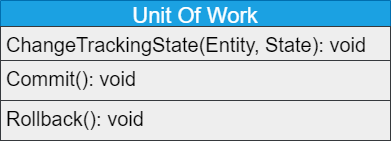Unit Of Work
Матеріал з Вікіпедії — вільної енциклопедії.

Unit Of Work — патерн об'єктно-реляційної поведінки, мета якого полягає у відстежуванні зміни об'єктів під час транзакції. Часто використовується із патерном Repository.
Під час роботи із базою даних важливо відстежувати зміни в об'єктах, в іншому випадку дані не будуть оновлені. Це також вірно для операцій додавання та видалення.
Можна змінювати дані в сховищі при кожній взаємодії з об'єктом, але це призведе до багатьох викликів у базу даних. Очевидно це потребує підтримування транзакції відкритою, що впливає на продуктивність роботи.
Даний шаблон пропонує відстежувати всі зміни над об'єктами та вносити їх у вигляді єдиної транзакції.
- UnitOfWork покликаний відстежувати всі зміни даних, які ми здійснюємо з доменною моделлю в рамках бізнес-транзакції. Після того, як бізнес-транзакція закривається, всі зміни потрапляють в БД у вигляді єдиної транзакції.
- Фабрика для репозиторіїв
- Лінива ініціалізація репозиторіїв (залежно від реалізації)
- Забезпечує використання одного з'єднання до БД усіма репозиторіями
- Зростає кількість класів
Розглянемо спочатку реалізацію шаблону запропоновану Мартіном Фаулером. Вона передбачає методи для відстеження змін в об'єктах та здійснення транзакції.
public class UnitOfWork
{
// методи для відстеження стану об'єктів
public void RegisterAdd(object newObject)
{
...
}
public void RegisterUpdate(object newObject)
{
...
}
public void RegisterDelete(object newObject)
{
...
}
// методи для здійснення транзакції
public void Commit()
{
...
}
public void Rollback()
{
...
}
}
Даний шаблон можна адаптувати, до мови програмування. Таким чином використаємо Entity Framework. Нехай дано деякі класи сутностей.
public class User { ... }
public class Apartment { ... }
public class Bill { ... }
А також припустимо, що патерн Repository для цих сутностей вже реалізований.
Запишемо інтерфейс до Unit Of Work та його реалізацію. Нам більше не потрібно відстежувати зміни у сутностях через те, що ця поведінка реалізована у Entity Framework. Але також це означає, що у нас виникнуть складнощі при зміні фреймворку.
public interface IUnitOfWork
{
IUserRepository UserRepository { get; }
IApartmentRepository ApartmentRepository { get; }
IBillRepository BillRepository { get; }
void Update<TEntity>(TEntity entityToUpdate) where TEntity : class;
int Save();
}
Найпростіша реалізація матиме наступний вигляд:
public class UnitOfWork : IUnitOfWork
{
// поля
private readonly DbContext dataBaseContext;
private readonly IUserRepository userRepository;
private readonly IApartmentRepository apartmentRepository;
private readonly IBillRepository billRepository;
// конструктори
public UnitOfWork(DbContext dataBaseContext)
{
this.dataBaseContext = dataBaseContext;
this.userRepository = new UserRepository(dataBaseContext);
this.apartmentRepository = new ApartmentRepository(dataBaseContext);
this.billRepository = new BillRepository(dataBaseContext);
}
// властивості
public IUserRepository UserRepository => userRepository;
public IApartmentRepository ApartmentRepository => apartmentRepository;
public IBillRepository BillRepository => billRepository;
// методи
public int Save()
{
return dataBaseContext.SaveChanges();
}
public void Update<TEntity>(TEntity entityToUpdate) where TEntity : class
{
if (dataBaseContext.Entry(entityToUpdate).State == EntityState.Detached)
{
dataBaseContext.Set<TEntity>().Attach(entityToUpdate);
}
dataBaseContext.Entry(entityToUpdate).State = EntityState.Modified;
}
}
Недолік полягає у створенні всіх репозиторіїв при ініціалізації Unit Of Work. Забезпечимо їх ліниву ініціалізацію. Перепишемо властивості наступним чином:
...
public IUserRepository UserRepository
{
get
{
if (userRepository == null) userRepository = new UserRepository(dataBaseContext);
return userRepository;
}
}
...
Якщо з'являється необхідність додати нову сутність — доведеться кожний раз редагувати клас та інтерфейс, що вміщюють логіку Unit Of Work.
Також актуалізується проблема неможливості вибору специфічної реалізації репозиторію (наприклад, покращеної версії). Вирішити такі проблеми можна, наприклад, наступним чином:
public interface IUnitOfWork
{
TRepository GetRepository<TEntity, TRepository>()
where TEntity : class
where TRepository : IRepository<TEntity>, new();
void Update<TEntity>(TEntity entityToUpdate) where TEntity : class;
int Save();
}
public class UnitOfWork : IUnitOfWork
{
// поля
private readonly DbContext dataBaseContext;
private readonly IDictionary<Type, object> repositoriesFactory;
// конструктори
public UnitOfWork(DbContext dataBaseContext)
{
this.dataBaseContext = dataBaseContext;
this.repositoriesFactory = new Dictionary<Type, object>();
}
// методи
public TRepository GetRepository<TEntity, TRepository>()
where TEntity : class
where TRepository : IRepository<TEntity>, new()
{
Type key = typeof(TEntity);
// add repo, lazy loading
if (!repositoriesFactory.ContainsKey(key))
{
TRepository repository = new TRepository();
repository.SetDbContext(dataBaseContext);
repositoriesFactory.Add(key, repository);
}
// return repository
return (TRepository)repositoriesFactory[key];
}
...
}
У нинішніх реаліях важливо контролювати доступ багатьох потоків до репозиторію. Поряд із стандартними блокуваннями можна використати вбудовані можливості С#, зокрема клас ConcurrentDictionary: Реалізація може виглядати так:
public class UnitOfWork : IUnitOfWork
{
// поля
private readonly DbContext dataBaseContext;
private readonly ConcurrentDictionary<Type, object> repositoriesFactory;
// конструктори
public UnitOfWork(DbContext dataBaseContext)
{
this.dataBaseContext = dataBaseContext;
this.repositoriesFactory = new ConcurrentDictionary<Type, object>();
}
// методи
public TRepository GetRepository<TEntity, TRepository>()
where TEntity : class
where TRepository : IRepository<TEntity>, new()
{
Type key = typeof(TEntity);
// add repo, lazy loading
return (TRepository)repositoriesFactory.GetOrAdd(key, factory =>
{
TRepository repository = new TRepository();
repository.SetDbContext(dataBaseContext);
return repository;
});
}
...
}
Залишилось вирішити, те що метод GetRepository працює із реалізацією, а не абстракцією. Скористаємось фабрикою
public class UnitOfWork : IUnitOfWork
{
// поля
private readonly DbContext dataBaseContext;
private readonly ConcurrentDictionary<Type, object> repositories;
private readonly IDictionary<Type, Func<object>> repositoriesFactory;
// конструктори
public UnitOfWork(DbContext dataBaseContext)
{
this.dataBaseContext = dataBaseContext;
this.repositoriesFactory = InitializeRepositoriesFactory();
this.repositories = new ConcurrentDictionary<Type, object>();
}
private IDictionary<Type, Func<object>> InitializeRepositoriesFactory()
{
return new Dictionary<Type, Func<object>>()
{
[typeof(IUserRepository)] = () => new UserRepository(dataBaseContext),
. . .
};
}
public void RegisterRepositoriesFromAssembly(Assembly assembly)
{
. . .
}
private void RegisterRepository(Type key, IRepository repository)
{
. . .
}
// методи
public TRepositoryInterface GetRepository<TRepositoryInterface>()
{
Type key = typeof(TRepositoryInterface);
return (TRepositoryInterface)repositories.GetOrAdd(key, repositoriesFactory[key].Invoke());
}
...
}
- Unit Of Work та Repository часто[джерело?] використовують в парі.
- Implementing the repository and unit of work patterns [Архівовано 18 червня 2019 у Wayback Machine.]
- Repository and unit of work pattern [Архівовано 10 серпня 2020 у Wayback Machine.]
- Common mistakes with the repository pattern [Архівовано 13 червня 2019 у Wayback Machine.]
Text is available under the CC BY-SA 4.0 license; additional terms may apply.
Images, videos and audio are available under their respective licenses.
